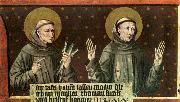La Peinture à l'huile en gros de Chine & Encadre |
|||||||||||

|
|||||||||||
|
|
|
||||||||||||||
|
michael pacher
Michael Pacher (c. 1435??August 1498) was an Austrian Tyrolean painter and sculptor active during the last quarter of the 15th century. His best-known work is the altarpiece at the church in the village of St. Wolfgang, Austria. This altarpiece contains scenes from the life of Jesus and the Virgin Mary. His influence is primarily North Italian, and his work shares characteristics with that of painters such as Andrea Mantegna; however, German influences are also evident in his work, especially in his wood sculpture. He was most active from 1462 until his death. Pacher was one of the earliest artists to introduce the principles of Renaissance painting into Germany. He was a comprehensive artist with a broad range of skills: sculpting, painting, and architecture of complex wood and stone. He painted structures for altarpieces on a scale unparalleled in North European art. His work is frequently correlated with the work of Andrea Mantegna. |
||||||||||||||
|
|
||||||||||||||
|
||||||||||||||
|
|
||||||||||||||
| michael pacher
Michael Pacher (c. 1435??August 1498) was an Austrian Tyrolean painter and sculptor active during the last quarter of the 15th century. His best-known work is the altarpiece at the church in the village of St. Wolfgang, Austria. This altarpiece contains scenes from the life of Jesus and the Virgin Mary. His influence is primarily North Italian, and his work shares characteristics with that of painters such as Andrea Mantegna; however, German influences are also evident in his work, especially in his wood sculpture. He was most active from 1462 until his death. Pacher was one of the earliest artists to introduce the principles of Renaissance painting into Germany. He was a comprehensive artist with a broad range of skills: sculpting, painting, and architecture of complex wood and stone. He painted structures for altarpieces on a scale unparalleled in North European art. His work is frequently correlated with the work of Andrea Mantegna. St_Anthony_of_Padua_and_St_Francis_of_Assisi 1477 Tempera oan pine panel, 54,5 x 93,5 cm Museum of Fine Arts, Budapest According to several scholars, Friedrich Pacher was the famous Michael Pacher's relative and collaborator. His style developed under the influence of Michael. This panel is one half of a predella which consisted of two parts for the representation of the most highly revered saints of the Franciscan order. The other side also depicts Franciscan saints. This panel adorned the lower, not very clearly visible, subordinate addition to a major altarpiece, hence the modest colour scheme content to forgo variety. Gaunt faces with strong cheek-bones, receding chins and thin lips are frequent in the master's oeuvre. The minutely elaborate broken folds, particularly at the elbows of sleeves, reveal the important part of sculpture in the activities of Michael Pacher, the most outstanding member of the studio, and also the deep absorption of sculptural forms in his style of far-reaching influence. The text giving the names of the donors and the date in fine Gothic minuscules occupies an outstanding place in the lower image field.Artist:PACHER, Friedrich Title: St Anthony of Padua and St Francis of Assisi Painted in 1451-1500 School 1477 Tempera oan pine panel, 54,5 x 93,5 cm Museum of Fine Arts, Budapest According to several scholars, Friedrich Pacher was the famous Michael Pacher's relative and collaborator. His style developed under the influence of Michael. This panel is one half of a predella which consisted of two parts for the representation of the most highly revered saints of the Franciscan order. The other side also depicts Franciscan saints. This panel adorned the lower, not very clearly visible, subordinate addition to a major altarpiece, hence the modest colour scheme content to forgo variety. Gaunt faces with strong cheek-bones, receding chins and thin lips are frequent in the master's oeuvre. The minutely elaborate broken folds, particularly at the elbows of sleeves, reveal the important part of sculpture in the activities of Michael Pacher, the most outstanding member of the studio, and also the deep absorption of sculptural forms in his style of far-reaching influence. The text giving the names of the donors and the date in fine Gothic minuscules occupies an outstanding place in the lower image field.Artist:PACHER, Friedrich Title: St Anthony of Padua and St Francis of Assisi Painted in 1451-1500 School |
||||||||||||||
|
Related Paintings to michael pacher :. |
||||||||||||||
|
|
||||||||||||||
|
|
||||||||||||||
|
CONTACTER DES Etats-Unis |







